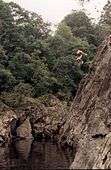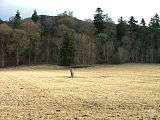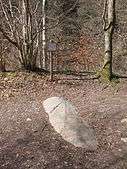Battle of Killiecrankie
| Battle of Killiecrankie | |||||||
|---|---|---|---|---|---|---|---|
| Part of the Jacobite Rising | |||||||
 Pass of Killiecrankie, from an 1802 book | |||||||
| |||||||
| Belligerents | |||||||
| Jacobite Royalists (Highlanders & Irish) | Orange Covenantor Royalists (Highlanders & Lowlanders) | ||||||
| Commanders and leaders | |||||||
| John Graham of Claverhouse, 1st Viscount Dundee† | Hugh Mackay | ||||||
| Strength | |||||||
| 3,000 foot[1] | 4,000 foot[1] | ||||||
| Casualties and losses | |||||||
| Over 600, inc. Dundee[2][3] | Up to 2,000[4][3] | ||||||
 Location within Scotland | |||||||
The Battle of Killiecrankie (Gaelic: Cath Raon Ruairidh) was fought between Highland Scottish clans supporting King James II and VII and troops supporting King William of Orange on 27 July 1689, during the first Jacobite uprising. Although it was a stunning victory for the Jacobites, it had little overall effect on the outcome of the war and left their leader dead. Their forces were scattered at the Battle of Dunkeld the next month.
The battlefield has been included in the Inventory of Historic Battlefields in Scotland and protected by Historic Scotland under the Scottish Historical Environment Policy of 2009.[5] The battle is remembered in four songs known as The Braes o' Killiecrankie, of which the best known was published by James Hogg.
Historical settings
A new king
William of Orange, invited to England by certain key members of a Parliament displeased at having a Catholic king, invaded in 1688. King James fled the country on 23 December, and, in February 1689, the English Parliament declared that, by fleeing, James had abdicated. Parliament then offered the throne jointly to William and Mary, the Protestant daughter of James to whom William largely owed his claim to the throne.
Scotland was a divided country politically, culturally, and religiously. The Stuarts had ruled Scotland since the time of Robert II in the late 14th century, and had also sat on the English throne since 1603. The Scottish Gaelic-speaking, mostly Catholic and Episcopalian Highlanders tended to stay loyal to the Stuart king James VII, while the English-speaking, mostly Presbyterian Lowlanders—who were the majority and held most of the political power in Scotland—tended to support William of Orange.
Birth of Jacobitism
A convention held on 14 March 1689 in Edinburgh decided that the Scottish government would pledge loyalty to William of Orange.
A number of people opposed this, including many of the Highland clans and John Graham, 1st Viscount Dundee, a lowland Scot and Episcopalian. Dundee left the Convention, planning with others loyal to King James (called Jacobites, from the Latin for James, Jacobus) to summon another convention at Stirling in James's name. The others, irresolute, decided to attend the Edinburgh Convention once more, and asked Dundee to delay his departure. He refused, and with some retainers retired to his home, Dudhope Castle near Dundee. When summoned to lay down his arms and return to the Convention, he wrote back, pointing out that he was not, in fact, in arms, that there were threats against his life in Edinburgh, and that his wife was about to give birth, and requested that the summons be either revoked or delayed. Instead, the Estates declared him a rebel and a fugitive on 30 March. On 4 April they declared that King James had forfeited the throne, and on 11 April offered it to William and Mary. Dundee raised the royal standard on Dundee Law, and left for the Highlands to raise an army.
Prelude
Sir Ewen Cameron of Lochiel, Chief of Clan Cameron, had set about forming a confederation of Highland clans loyal to James as soon as William had arrived in England, and Dundee was in contact with him. When Dundee went north, he was pursued by a governmental force of about 3,500, led by General Hugh Mackay of Scourie, a Highlander who had been in Dutch service with the Scots Brigade for many years. Dundee, moving quickly, outmanoeuvered Mackay, and on 16 May arrived in Glenroy, where the clans had been summoned to meet him on 18 May. With a total of some 1800 men, Dundee marched, in hopes of meeting Mackay on grounds favourable to the Highlanders. Unable to do so, he retreated back to Glenroy, where he arrived on 11 June. Many of the Highlanders returned to their homes, but some remained.
Blair Castle was in a key position that controlled access to the Lowlands. It was owned by the Marquis of Atholl; he promptly headed south to Bath to take the waters for his health. His heir, Lord Murray, was on the government's side. Dundee ordered Patrick Steuart of Ballechin, a relative of the Murrays, to hold Blair Castle for the King; Lord Murray ended up besieging his own castle. Dundee learned that Mackay was at Perth, on his way to assist in taking Blair Castle.
Dundee was determined to intercept Mackay near Blair Atholl, astride the road through the hills that Mackay would have to pass. Many of the clans had not arrived yet, but he set out anyway and ordered them to follow "with all haste." Ewen himself also had a force of about 240 Camerons with him at the time, and tried to catch up while he dispatched his sons to raise support along the path of march. Ewen overtook Dundee just before he reached Athole, where they were joined by about 300 Irish, under the command of Major-General Cannon.
Battle

Dundee held a quick war council with those clan leaders who had arrived, and then immediately set out for the field with his force, now numbering about 2,400. He arrived at the pass before Mackay and set up position on a ridge above the pass. When Mackay's troops arrived, they saw they had no hope of attacking Dundee's force. They instead deployed in a line and started firing on them with muskets.
The Jacobite line was shorter than the Government's, due to the disparity in numbers, leaving Ewen in the middle with an open flank on the left. By the time all of the forces were formed up, it was late afternoon, and the Jacobites had the sun in their eyes, so they simply waited for sunset under the desultory fire from Mackay's forces.
At seven o'clock, Dundee gave the order to advance, at which point the entirety of the Highlanders dropped their gear, fired what muskets they had, and charged. Mackay's forces, realising the battle was on, stepped up their rate of fire; however, due to a shallow terrace on the hillside shielding the advancing Jacobites, this fire was partly masked.[6] Eventually the lines met, and Mackay's men in the centre were "swept away by the furious onset of the Camerons". So fast was the Jacobite charge that many government troops had insufficient time to fix their bayonets, leaving them defenceless at close quarters. (During this period, the plug bayonet was used, which fitted into the barrel of the musket and prevented further reloading or firing—this meant that fixing bayonets was delayed until the last possible moment.) The battle soon ended with the entirety of Mackay's force fleeing the field, quickly turning into a rout in which 2,000 were killed.[4]
However, the cost of victory was enormous. About one-third of the Highlander force was killed, and Dundee was fatally wounded towards the end of the battle. The Jacobite advance continued until it was stopped by government forces at the Battle of Dunkeld.
Site investigations
In 2004, a fragment of a hand grenade was found on the site. This is thought to be evidance of the first use in combat of a grenade in Britain.[7] Between August and October 2015, an archaeological survey of the site was undertaken in preparation for the improvement of the A9 road.[8] Finds included a copper alloy pendant, horse shoes, buttons, musket munitions, two buckles and part of the support for a sword belt. Transport Minister Derek Mackay said "Thanks to the survey work, experts are shedding more light on the Battle of Killiecrankie which took place over three hundred years ago, bringing 'Bonnie Dundee's' Jacobite victory to life. They are able to offer more information on the battle including the possible route soldiers took during the battle, potential cavalry positions, where the key skirmishes and close quarters fighting took place, and the likely retreating route taken by the fleeing government forces."[9][10]
Battle gallery
| The Battle of Killiecrankie | ||||||||
|---|---|---|---|---|---|---|---|---|
|
Notes
- 1 2 Chisholm 1911, p. 795.
- ↑ Prebble 1966, p. 76.
- 1 2 Fraser, Sarah (2012). The Last Highlander: Scotland's Most Notorious Clan Chief, Rebel & Double Agent. p. 24. ISBN 978-0-00-722950-5.
- 1 2 Hill 1986, p. 73.
- ↑ "Inventory battlefields". Historic Scotland. Retrieved 2012-04-12.
- ↑ Pollard & Oliver, Tony & Neil. Two Men in a Trench II: Uncovering the Secrets of British Battlefields. London: Michael Joseph, 2003.
- ↑ "First grenade found at Killiecrankie". The Scotsman. 2004-02-22. Retrieved 2016-03-04.
- ↑ "Killiecrankie Battlefield Metal Detecting Survey". GUARD Archaeology. March 2016. Retrieved 2016-03-04.
- ↑ Ferguson, Brian (2016-03-03). "Dozens of Battle of Killiecrankie artefacts unearthed at A9 roadworks". The Scotsman. Retrieved 2016-03-04.
- ↑ "Battle of Killiecrankie artefacts found during A9 dualling survey". BBC News Online. 2016-03-03. Retrieved 2016-03-04.
References
-
 Chisholm, Hugh, ed. (1911). "Killiecrankie". Encyclopædia Britannica. 15 (11th ed.). Cambridge University Press. p. 795.
Chisholm, Hugh, ed. (1911). "Killiecrankie". Encyclopædia Britannica. 15 (11th ed.). Cambridge University Press. p. 795. - Hill, James Michael (1986). Celtic Warfare 1595–1763. Edinburgh: John Donald Publishers Ltd. ISBN 0-85976-151-7.
- Prebble, John (1966). Glencoe: The Story of the Massacre. London: Secker and Warburg. ISBN 978-0-436-38602-2.
Further reading
- Reid, Stuart (2009). The Battle of Kiellliecrankkie. Partizan Press.
- Article on the battle at History Focus
- Article on the battle at scotsmag.com
- Article on the battle at Electric Scotland



